America's First Gold Eagles: Part II
By June of 1797, Robert Scot, the US Mint’s Chief Engraver, had heard enough of the complaining about the “scrawny eagle” and the “sickly eagle” from other US Mint officials and by the general public.
By June of 1797, Robert Scot, the US Mint’s Chief Engraver, had heard enough of the complaining about the “scrawny eagle” and the “sickly eagle” from other US Mint officials and by the general public. So at the insistence of the new US Mint Director, Elias Boudinot, he began to remodel the eagle design. The obverse had received only minimal complaints, but the small eagle on the reverse was another story altogether. It was not the image that the fledgling United States wanted to portray to the world.
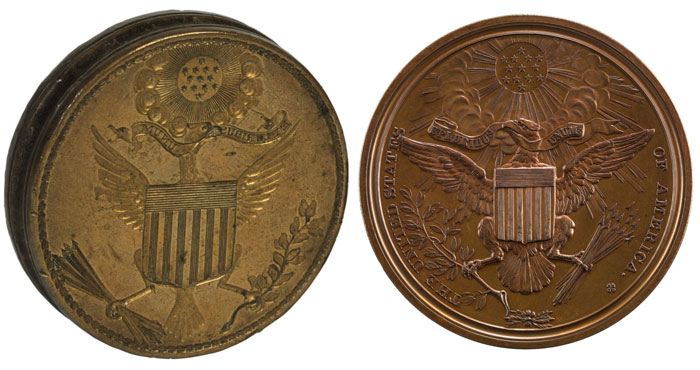 Left: The Original of the Great Seal of the United States.
Left: The Original of the Great Seal of the United States.
Right: Augustin Dupre's Declaration of American Independence Medal - Image from the Smithsonian Institution - US Mint dies.
Other contemporary silver coinage of the world depicted these majestic
eagles, shields covering their bodies and either swords or scepters in
their talons. The 1780 Maria Theresa Thaler of Austria is a prime example
of a majestic bird gracing a large coin. Those avian creatures symbolically
displayed regal power and might. Perhaps Scot was influenced by these
foreign competitors. Or, perhaps, he was influenced by a source much closer
to home.
The Great Seal of the United States was the national symbol representing the United States. It was originally adopted in 1782, some 15 years before he revised the $10 Gold Coin. The first depiction of the Great Seal also depicted a somewhat scrawny eagle and records indicate that Robert Scot was paid a fee for a seal in 1782 by the US Government.
According to Cornelius Vermeule, in his ‘Numismatic Art in America,’ “the design of heraldic eagle reverse can also be traced back through the coinages of the newly independent states to[Augustin]Dupre’s medal commemorating the Declaration of American Independence, which was struck in Paris shortly after the Revolution. This creation was termed the Diplomatic medal, since it was conceived as a work of art suitable in the precious metals for the presentation to foreign statesmen who had aided the colonies on their struggle for freedom.”
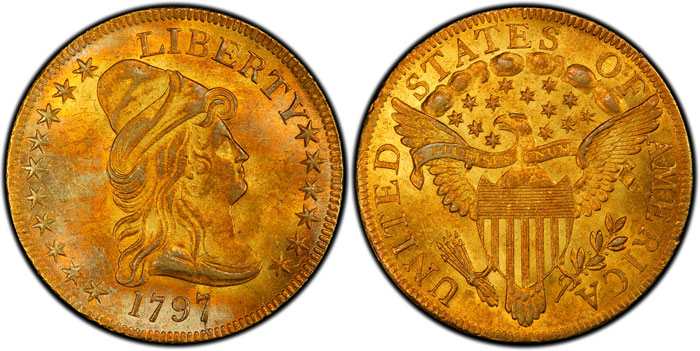
FIRST YEAR OF THE NEW DESIGN
Scot was likely inspired by Dupre’s design as his Heraldic Eagle is more majestic and robust. The new reverse design was implemented in June of 1797 and although 3,615 of the prior 1797-dated Small Eagle coins were struck that year, an additional 10,940 coins were minted bearing the new Heraldic Eagle. But even the new Heraldic Eagle design was not without controversy. The eagle holds in the dominant claw (the right claw) a bundle of arrows (representing war) and in the left claw it holds an olive branch (representing peace). Because the right claw held arrows it was thought to mean that the United States preferred war over peace. Whether this was an aberration or how Scot actually felt is unknown.
His re-designed eagle is now much larger and more majestic. His outstretched wings are the appropriate size for the bird depicted. In his beak is a scroll with “E PLURIBUS UNUM” on it. The shield covering his body contains 13 vertical stripes. The aforementioned bundle of arrows is clenched in his right talon and a single olive branch in his left.
Thirteen six-pointed stars are arranged immediately over his head, with a grouping of clouds above. Around the periphery, boldly, is “UNITED STATES OF AMERICA.” No weight or denomination is stated as was the custom. The value was determined by the actual size, weight and metallic composition of the coin itself.
A major difference to the obverse was that Miss Liberty’s bust was now surrounded by 10 six-pointed stars to the left and 6 six-pointed stars to the right. Despite the 1797 Heraldic Eagle’s scant mintage of 10,940, a number of Uncirculated examples do exist. Presently PCGS has graded 44 Uncirculated examples while NGC has graded 168 coins with 48 Uncirculated coins and CAC has awarded their sticker to 17 coins. There are but 3 different die varieties for the 1797 Draped Bust Heraldic Eagle gold coin.

A Close-Up of the 1798/7 Overdate - Images from PCGS
THE SECOND YEAR – 1798
As 1798 came into view, the decision was made that, regardless of the number of current states, only 13 stars would adorn US coinage. The 1798 Draped Bust Heraldic Eagle Gold coins would have two distinct varieties—one with 9 Stars to the left, 4 stars to the right—and another with 7 stars to the left, 6 stars to the right. The decision to display only 13 stars and the ensuing re-engraving of the dies certainly interfered with the actual striking of these coins as only 900 coins were struck that had the 9 and 4 stars combination. The 7 and 6 stars combination is even rarer with a scant 842 coins struck. All 1798-dated coins are actually overdates with an 8 over a 7 in the last digit of the date.
VARIETY 1 – 1798/7 9 STARS LEFT, 4 STARS RIGHT
This overdate coin is rare. Of the 900 struck NGC has graded only 24 coins with 5 in Uncirculated, while PCGS has graded 38 coins with 4 of those in Mint State and CAC has stickered 3 coins. There are no 1798 coins in existence that are not 1798/7 overdates.
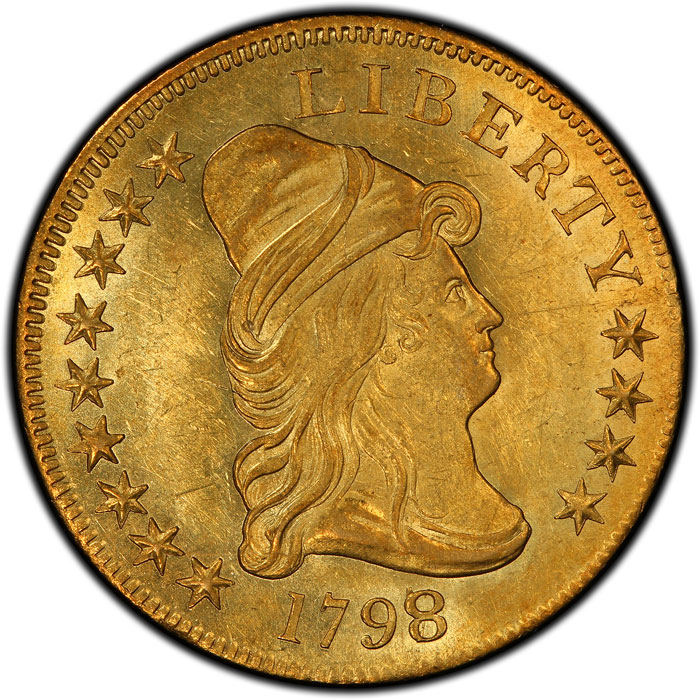
VARIETY 2 – 1798/7 7 STARS LEFT, 6 STARS RIGHT
This variety of 1798/7 Capped Bust $10 Gold is even rarer than its Variety 1 counterpart. Only 842 coins were struck at the Philadelphia Mint so this coin is exceedingly rare in any grade. PCGS has graded 11 of these coins with 4 in Mint State while NGC has graded 3 coins with none in Mint State, with CAC stickering only 2 coins.
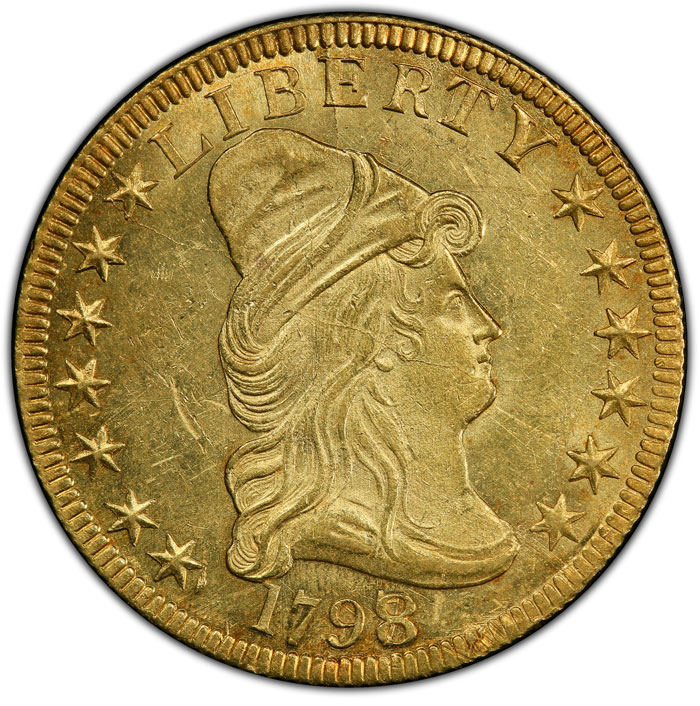 THE THIRD YEAR – 1799
THE THIRD YEAR – 1799
As the 19thCentury approached, the numbers of Capped Bust $10 Gold coins struck swelled to 37,449 but, again, there are two distinct varieties. These varieties are not as easy to discern as counting stars on the obverse. The two varieties were caused by the actual size of the stars that were used on the obverse to represent the 13 original colonies. Along with the 1801-dated coins, the 1799-dated coins are the dates that are most frequently encountered.
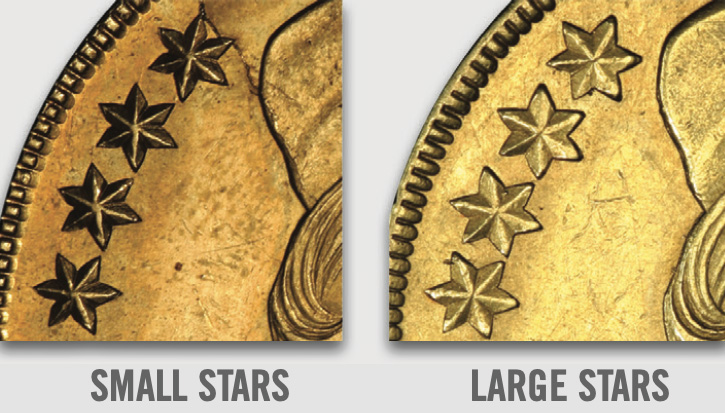
VARIETY 1 – SMALL OBVERSE STARS
No one knows for certain how many coins of each variety were actually struck, but unlike the 1798/7 varieties there is no apparent difference in price. Comparison of the two varieties side-by-side is the easiest way to determine the size of the stars as well as the distance of the stars to the rim of the coin. NGC has graded 53 of the Small Obverse Stars coins, with 22 of them in Mint State grades while PCGS has graded 191 coins with 79 coins grading Mint State. CAC has awarded 28 coins their sticker.
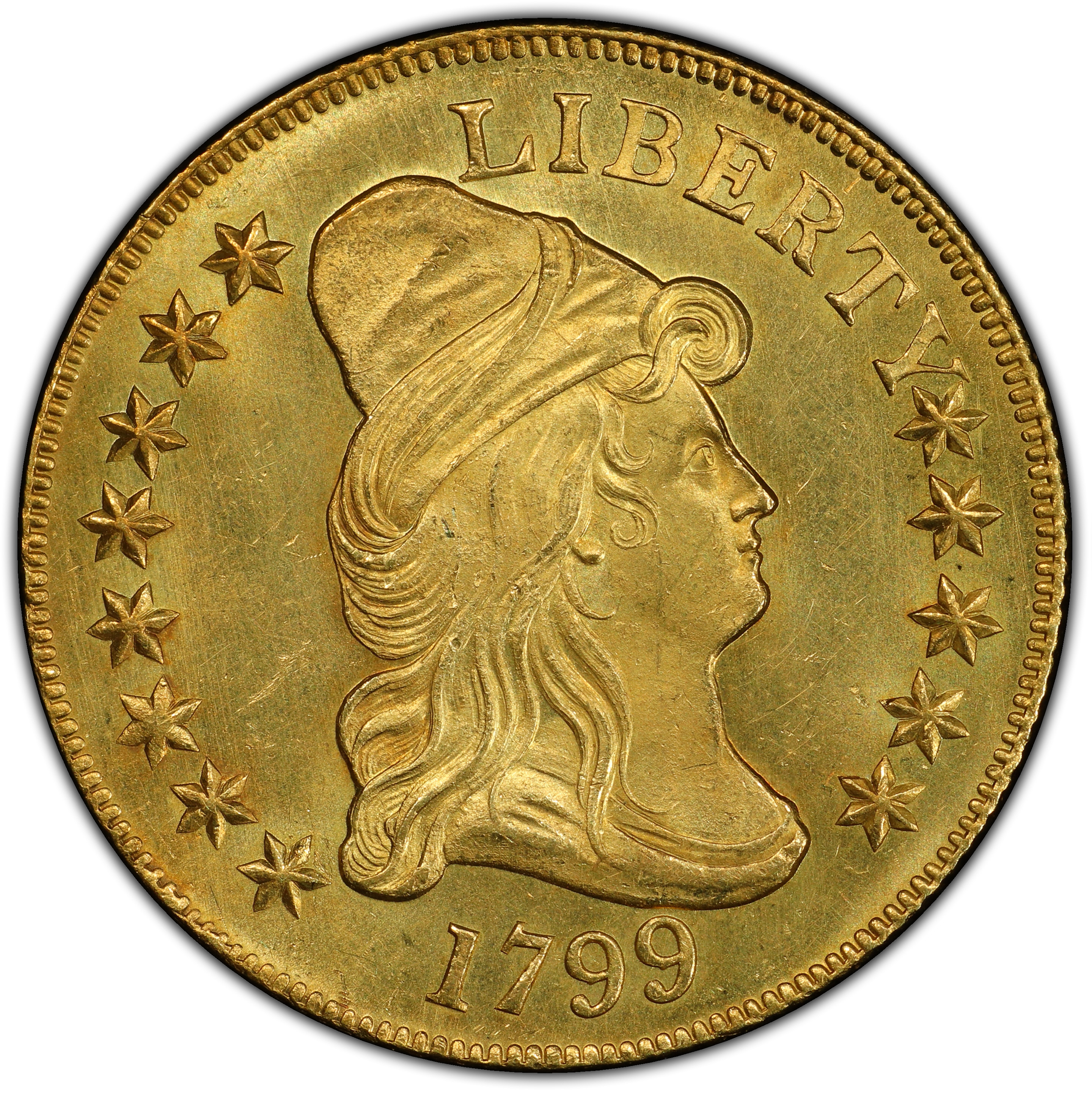
VARIETY 2 – LARGE OBVERSE STARS
The Large Obverse Stars coin has 148 Mint State examples out of 479 coins graded by PCGS. NGC has graded 372 coins all in grades with 187 in Mint State and CAC has stickered 50 coins.

THE YEAR 1800
The mintage once again dropped prohibitively in 1800. Only 5,999 coins were struck making it the third scarcest date in this short run of dates. But a high number of 1800-dated coins were preserved so the prices are not significantly higher than other dates. NGC has graded 107 coins with 42 of those in Uncirculated grades and also graded 2 coins as Specimen. PCGS has graded 162 coins with 49 coins graded as Mint State and 19 have received CAC stickers.
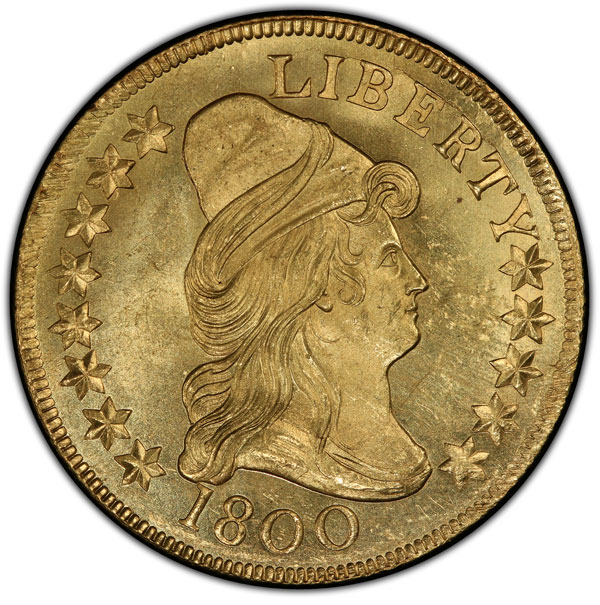
1801 – THE 19TH CENTURY
1801 was another date, like 1800, where there are no varieties and 44,344 coins were struck. That is the highest mintage in the entire series, including all of the Small Eagle early dates. It is one of the most plentiful dates of the series. PCGS has graded 538 coins, with a whopping 225 coins graded in Mint State. NGC has graded another 396 coins and 190 of those are Uncirculated while CAC has awarded 81 coins their green seal of approval.
No 1802-dated Capped Bust coins were struck.

THE NEXT TO LAST YEAR – 1803
During the year 1803, only 15,017 coins struck dated 1803. Once again, they were somewhat evenly divided between the two varieties—Small Reverse Stars and Large Reverse Stars. There is no difference in value in virtually any grade so the mintages are likely close in number to one another. There is a sub-variety of 1803 Large Reverse Stars that does not have a small 14th star hidden in the clouds.
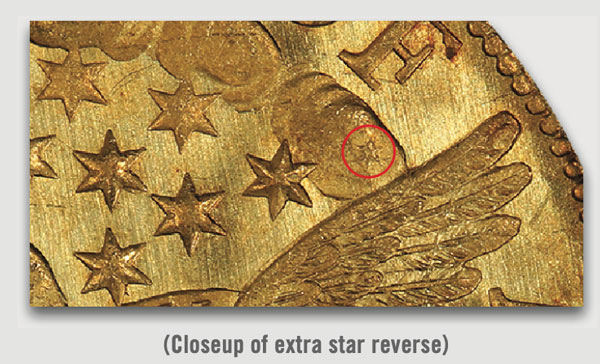
VARIETY 1 – SMALL REVERSE STARS
The stars in question are the 13 stars above the eagle. NGC has graded 50 coins with 24 of those in Mint State, while PCGS has graded 170 coins with 61 coins in Mint State. 31 coins have received the CAC sticker of approval.
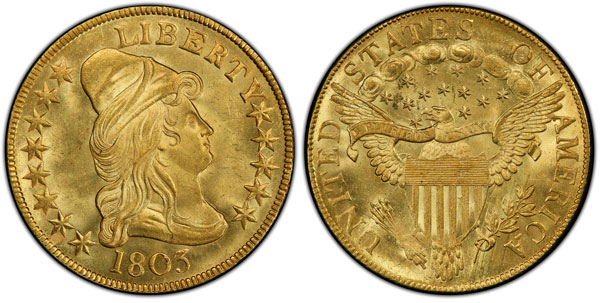
VARIETY 2 – LARGE REVERSE STARS
You will note in the photograph that a number of these stars above the eagle on the reverse are touching the cloud while on the Small Stars Variety they do not touch the clouds whatsoever. PCGS has graded only 47 coins, with 22 grading as Mint State, NGC has graded 45 coins, with 29 of those in Uncirculated grades. CAC has sticker a total of 10 coins of this variety. The numbers of certified specimens should give a price advantage to the greater rarity of the Large Stars variety.
There is a sub-variety with a 14th star that is sometimes visible in the cloud to the far right.
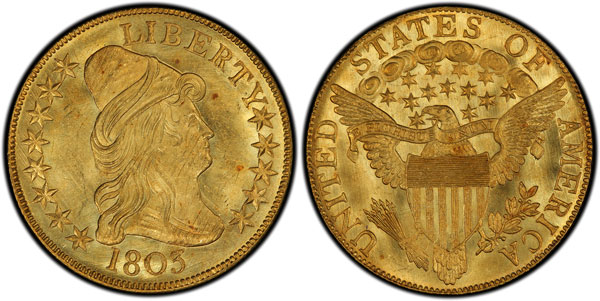
THE FINAL YEAR – 1804
A scant 3,757 coins were struck in that year and we know that all of them were the “Crosslet 4 Variety”. The other variety is a “Plain 4 Variety” struck only in Proof with a total of only 4 coins known.
VARIETY 1 – CROSSLET 4
Having such a low mintage even for the “Crosslet 4 Variety” makes it very popular and very valuable. NGC has graded 50 coins with 24 of them in Uncirculated coins while PCGS has graded 42 coins with 11 in Mint State, with 7 receiving a CAC sticker.
Reportedly, the US Mint struck a number of 1803-dated Capped Bust $10 Gold Eagles in 1804 as well as striking the 3,757 1804-dated coins later that year. However, the ‘Crosslet 4’ 1804 Eagles were melted in quantity that year so the total number of surviving specimens is quite low.
At the end of the 18th Century, the world price of gold rose quickly due to France’s “Reign of Terror” and the wars fought by Napoleon. Sizable quantities of all types of U.S. gold coins headed for Europe, to be melted there.
As the price of gold continued to rise in 1804, more US gold coins were melted. The simple fact was that the coins were worth more than their face value and one could make a considerable profit easily. In fact, much of the US Mint’s production of these Eagles went to bullion dealers as opposed to bankers and merchants who would use them in commerce. The situation was so serious in 1804 that President Thomas Jefferson ordered the cessation of striking the gold Eagle coins as well as Silver Dollars. Due to that presidential order, no further Eagle coins were struck for circulation until 1838.
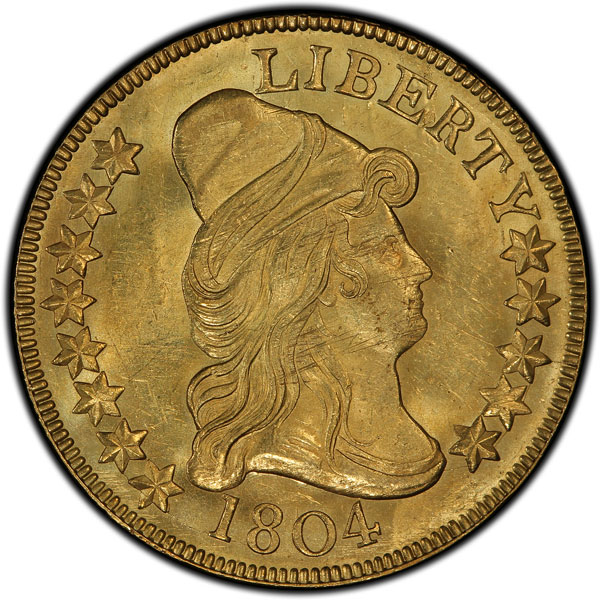
VARIETY 2 – PLAIN 4 IN PROOF
This coin is considered the “King” of this series with a known population of only 4 coins. There is only one coin that has been graded and that was by NGC which graded it as Proof-65*+ Ultra Cameo.
The reason for why the 1804, Plain 4, Proof coins were struck had its roots in diplomatic channels. In 1834, by order of President Andrew Jackson, the State Department, then known as the Department of Foreign Affairs had planned to give gifts of then-current US coinage to the rulers of four Asian nations—Muscat, Siam, Japan and Cochinchina (now Vietnam). Since President Jefferson had ordered the cessation of striking both the Silver Dollar and the Gold Eagle in 1804, neither coin had been struck for 30 years.
Putting the current 1834 date on a Silver Dollar or a Gold Eagle would certainly violate President Jefferson’s prohibition which was still in effect. The Secretary of State then ordered the US Mint Director to re-strike 4 1804-dated Silver Dollars and Gold Eagles. On the Gold Eagles, instead of using a die with a ‘Crosslet 4’ like the original coins, the restrikes had a ‘Plain 4’ instead.
The Emissary presented a set to the Sultan of Muscat and another to the King of Siam. But the diplomat drew ill and died of disease in Macao before his diplomatic mission could be completed. The remaining two sets of coins were returned to the United States.
The famous King of Siam set of coins was sold at auction by the heirs of Anna Leonowens, who was the schoolteacher to the children of the King of Siam. Of the four coins struck, three are in private collections and the fourth is on display at the American Numismatic Association’s Museum in Colorado Springs, Colorado. In January of 2021, the 1804 Plain 4, Gold Eagle originally part of the Sultan of Muscat’s set was sold by Heritage Auctions for $5,280,000.
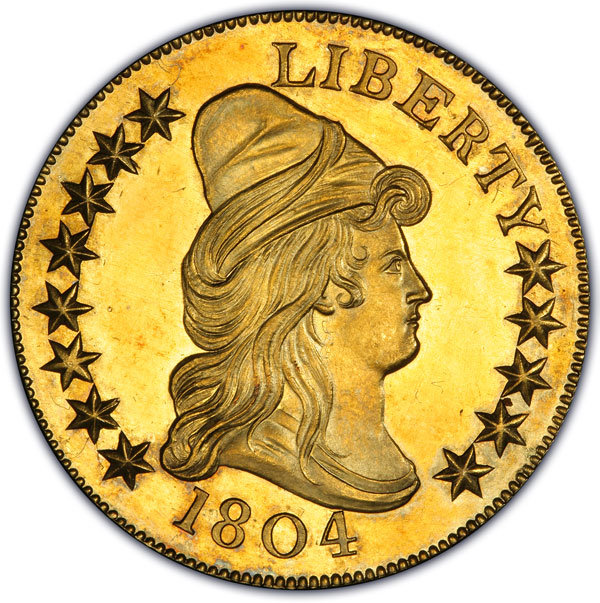
HOW TO GRADE THEM
Having the opportunity to grade these coins for a numismatist is a great privilege. Any wear on the coin will first be noticeable on the obverse on Miss Liberty’s hair, her cap, her cheek or on the drapery of her dress.
On the reverse, check the eagle’s wing tips and breast feathers are high points as are the clouds above the eagle. However, do not confuse a weak strike for wear as often these coins were not fully struck, given the minting technology of the day. In the early years of minting coins, overweight planchets were a common problem so adjustment marks often plague these early gold issues. These marks would certainly affect the value of the coin, if not also the grade.
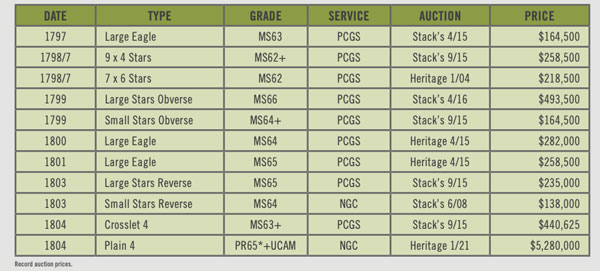
CURRENT AVAILABILITY
The two most commonly encountered coins are the 1799-dated coins and those dated 1801. You may be able to locate Mint State specimens with enough searching in the sales of major collections. The 1803-dated coins are the next most commonly found date. The 1800-dated coins are quite scarce but less so that the 1797. 1804 is a rare coin but its rarity is exceeded by both of the 1798/7 overdates. However, the 1804, Plain 4 Proof 4 is an exceptional rarity.
Most collectors will not try to assemble a set by variety due to the cost and availability. Many collectors are satisfied with a Small Eagle example and a Large Eagle specimen.
At public auction, this series has the attention of dealers and advanced collectors.
COLLECTABILITY
For a view on how investors and collectors look at these Draped Bust Large Eagle $10 gold coins, we asked someone who holds a significant number of them in his inventory and who offers them to both investors and collectors.
Michael Contursi is President of Rare Coin Wholesalers, of Irvine, California. This firm was founded by his father Steve, the current CEO, in 1990. They have handled many of the greatest rarities in American numismatics, such as purchasing the ‘King of Siam’ Proof Set, the 1794 Silver Dollar that may have been the first one struck, a Brasher Doubloon and a 1907 “Ultra” High Relief Saint-Gaudens $20 Gold coin. The Contursi family’s business philosophy is to purchase any rarity that meets their standards.
I asked Michael about these Early Draped Bust $10 Gold coins. “Unlike a lot of dealers, we don’t buy these coins to sell them to any specific investors or collectors. We have no idea who will buy them. We buy them because they are historical artifacts. That is what we like to sell to our investors and collectors,” Contursi said.
I then asked him what is so appealing about these coins that you have millions of dollars of them in your inventory. “These are our ‘Birth of Our Nation’ gold coins. They are very high-end coins that are a store of value as an investment to protect and grow wealth for these clients. For a very long time, we have been dealing in what we consider to be ‘elusive special assets.’ Once they are sold, it is very difficult to replace them. It is exciting to find them and even more exciting to own them,” Contursi concluded.
Even the experts look at these historical and amazing gold coins, from the time of our Founding Fathers with deep awe and respect.

Download the Greysheet app for access to pricing, news, events and your subscriptions.
Subscribe Now.

Subscribe to The Greysheet for the industry's most respected pricing and to read more articles just like this.
Author: Michael Garofalo


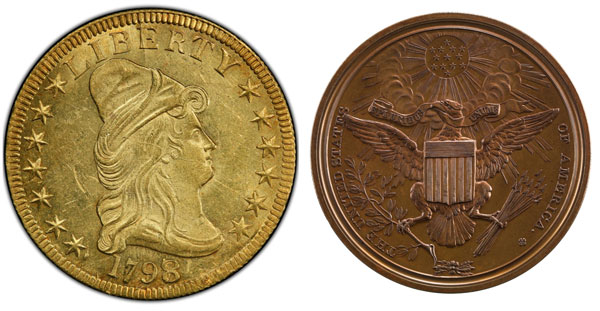






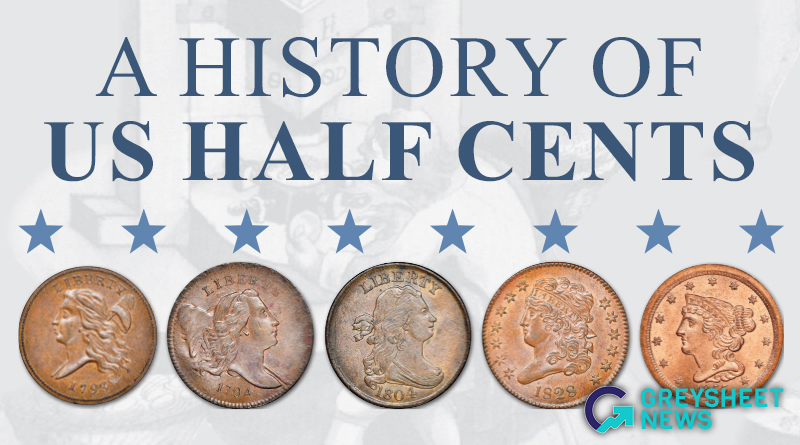
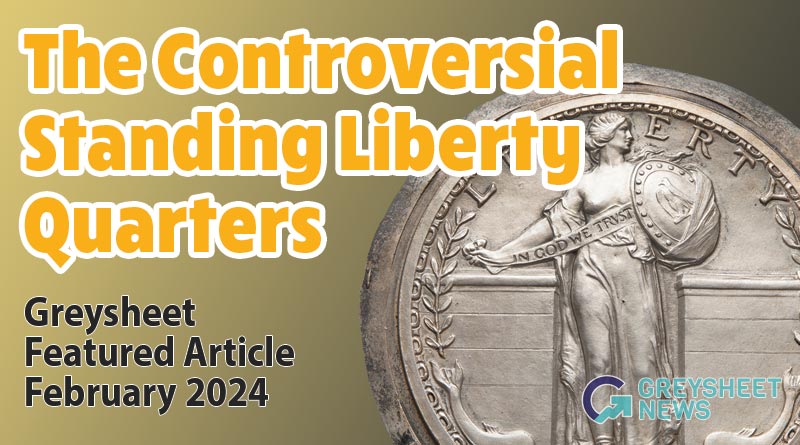
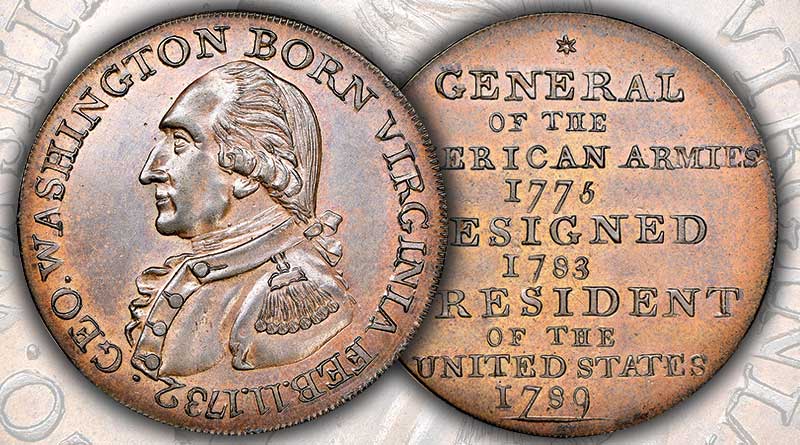
Please sign in or register to leave a comment.
Your identity will be restricted to first name/last initial, or a user ID you create.
Comment
Comments